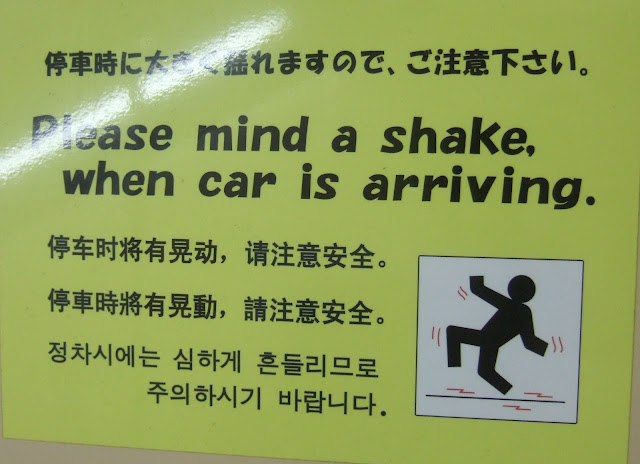It seems that whatever accommodation you book in Japan, they don’t want you to be there before 3pm. It’s a bit late to check in but they do keep your bags so it’s not the end of the world.
We arrived at another business hotel near the train station to drop off our bags and make our way to Matsumoto Castle.
In case you are wondering, business hotels are usually the cheapest accommodation for two in Japan and quite good value with a typical small room and what could barely be described as a double bed plus the usual ‘electronic’ bathroom, which is a very clean and efficient glorified portaloo.
Our hotel sold us discounted tickets to the castle and after a 15 minute walk or so made it to the entrance.
Sadly it’s not quite the original that would have been built around 1500 as it was disused from 1868 and was nearly demolished but was saved from that fate by some local campaigners. Even though it went through a series of reconstruction in the first part of the 20th century, it still looked majestic. The interior was mainly bare save for a few pieces of Edo time artefacts such as a Samurai outfit and also a collection of Matchlock rifles. The beams to construct this mainly wooden castle were very impressive however.
We enjoyed a few hours there and then walked around Matsumoto for a little while. It didn’t have much else to offer but its a pleasant town and it did make a good base for us to go and walk part of the Nakasendo Highway and also to make our way to the Alpen Route.
The next day, we made our way by train and bus to Magome to start a short walk (by our standards) of around 6 miles to Tsumago, part of the Nakasendo Trail, a trail that linked Edo (Tokyo) to Kyoto during the Tokugawa Shogunate.
Magome and Tsumago are two posttowns that have been restored to a state of how they would have looked like during Edo days and it’s easy to get ‘snap happy’ and take many photos.
The walk itself wasn’t strenuous unlike the one around Fuji we had recently done, it was like going for a walk in the Downs of Sussex, pleasant, bucolic and photogenic although there were bear warnings!
I think it only took us a couple of hours to amble our way to Tsumago and we enjoyed a great bowl of Soba noodles with Gohei-Mochi (a toasted rice ball) before heading back to Matsumoto.
Another early start the next day to get a train a 7am or so to Shinano-Omachi (I know, I know it’s not that early) and go on an epic adventure across the Alps of Japan.
When we looked at the highlights of Japan and what we were interested in seeing and doing, this was something we really wanted to do just for the sheer ‘Japanese-ness’ of it. This Alpen or Alpine route isn’t a walk across the mountains or even a bus journey or train journey but a collection of different transport methods to get from Ogisawa to Tateyama.
We arrived at Shinano-Omachi to board a local bus to take us to Ogisawa, the start of our journey.
From Ogisawa, a ten minute Trolley bus ride through the mountain and we arrived at Kurobe Dam the highest dam in Japan (possibly the biggest, I can’t recall the facts and won’t bore you with them), amazing scenery with the mountains all around.
Next , from Kurobe we took a Funicular up to another junction to then took a cable car up to Daikanbo, both stops offered fine panoramas.
After this was another Trolley bus through the mountain to Murodo, the highest point of the journey and a good place to get out and about and walk around which is exactly what we did for a couple of hours. Here we were right in the mountain range which was riddled with volcanic fissures which were steaming away and gave off a rather nasty pong!
Next stage was a bus down to Midagahara where we hoped we would see a caldera but sadly the clouds had started to roll in so not to be. We took the next bus down to Bijodaira which meandered slowly down the mountain and offered a great scenery then lastly another Funicular to take us down to Tateyama where we could catch a train to Toyama where we were staying for the night.
A crazy journey but great fun to travel on all the different methods of transport and something we won’t forget in a hurry!
From Toyama, an unimpressive town but still a very clean and efficient one as with all Japanese places, we made our way in the morning to Takayama.
Takayama is a bit of a tourist trap really, expensive eateries and souvenir shops etc.. and although we enjoyed walking around its pretty streets seeing the old buildings, there wasn’t anything we hadn’t already seen on the Nakasendo walk. Yep, getting complacent already!
The main reason we came here was to visit the Hida Folk Village, an open air museum. We like our architecture and nature, in case you didn’t know!
We thoroughly enjoyed walking around the site which had 30 plus buildings rescued from destruction when new reservoirs were being created in the Hida region. Mainly farm buildings built from wood and rope (no nails), they showed how people lived up until the 1960s before modernity tapped at their doors.
We said goodbye to the mountains and headed to the old capital Kyoto the following morning.
Matsumoto Castle
Nakasendo Walk
 |
| Who's Gus...!? |
Takayama Open Air Museum















































No comments:
Post a Comment